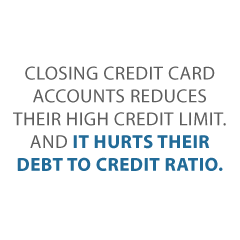Debt Consolidation And How It Affects Your Credit
Those blanket debt consolidation loans coming from debt consolidation companies can sometimes seem like they’re appealing. They can feel like a great way to manage both business and personal debt. However, this species of financial solution has its drawbacks for both business and personal credit. Let’s talk a little about each.
Personal Credit
On your personal credit report, this sort of financial solution can have several rather negative effects. Often when people use debt consolidation, they close all the credit accounts that they are consolidating. Often people convert their unsecured credit cards to a single installment loan.
For people who close accounts, the closing of those accounts generally hurts their credit score. Closing credit card accounts reduces their high credit limit. And it hurts their debt to credit ratio. This can also reduce the number of open positive accounts they have. And it can reduce the variety of credit types they are using.
But There’s More When it Comes to Debt Consolidation 
Furthermore, the debt consolidation loan typically involves a hard inquiry on their credit report. All of these factors have a generally negative impact on a consumer credit score. The changes in credit utilization (debt to credit ratio) alone can cause a significant credit score drop.
This is since credit utilization accounts for over 30% of a consumer’s credit score. You can drastically reduce the negative impact of consolidating debts by keeping the credit lines/credit cards open. Do this, rather than closing them.
Business Credit and Debt Consolidation
The scoring rules for business credit are different, but they serve the same purpose. So we can expect some of the same effects. If you keep your accounts open when consolidating business credit, it could actually boost your business credit scores. This is because those accounts will have a showing of being paid in full.
If a business uses a debt consolidation company, it may be the wrong idea. That’s because this is likely to be a move which future lenders and investors view negatively.
This is versus a consolidation loan from a bank. Debt consolidation loans from banks, however, are often quite helpful to businesses. And they usually do not have a serious negative score impact. But that is only as long as your consolidated accounts are not immediately closed.
Details on Business Credit Scoring
Company credit is credit in a company’s name. It doesn’t attach to an entrepreneur’s consumer credit, not even if the owner is a sole proprietor and the only employee of the business.
Hence, an entrepreneur’s business and consumer credit scores can be very different.
Some Business Credit Scores
1. Dun & Bradstreet’s PAYDEX Business Credit Score
A PAYDEX Score from Dun & Bradstreet runs from 0 to 100. This score has a basis in payment information which is on report to the agency. Or it is on report to data-gathering firms partnering with the CRA.
D & B uses this information, along with a credit score and Financial Stress Score, so as to advise just how much credit a lender should extend to your business.
Getting a PAYDEX Score
To get a PAYDEX score, you need to apply for a D-U-N-S number by using Dun & Bradstreet’s web site. The number is absolutely free. Plus the CRA will need to have records of your payments with four or more vendors.
Your firm’s PAYDEX score shows if your payments are normally made promptly or ahead of schedule. As you may expect, a higher number is better.
PAYDEX Score Details
The scores break down as follows:
- 80 – 100: A low risk of late payments
- 50 – 79: A medium risk of late payments
- 0 – 49: A high risk of late payments
D&B Business Credit Scores
Your company’s credit score runs from 1 to 5. 1 is the very best score. This matches your company with various other businesses with similar payment histories. The score demonstrates how usually those business often tend to pay without delay.
This information can truly aid loan providers to identify your business’s standing. But it does not really reflect every one of the payment records from your business.
Financial Stress Score
The Financial Stress Score also ranges from 1 to 5. It matches your business with various other firms sharing similar financial and business qualities.
These resemblances are in areas such as size or amount of time in business. This score demonstrates how regularly those businesses have a tendency to pay on time. As before, 1 is the very best score. This score is a more detailed examination of the business landscape, versus an evaluation of your company’s actual payment history.
An excellent PAYDEX score for your company is 80 – 100.
2. Experian Credit Scores
Experian’s scoring system is called Intelliscore Plus.
What is the Intelliscore Plus Credit Score?
The Intelliscore Plus credit score is a statistically based credit-risk analysis. The essential objective of Intelliscore Plus is to aid businesses, investors, and possible future loan providers make wise judgments regarding who they should or should not do business with.
Like an automobile dealer makes use of a customer’s FICO score to swiftly determine just how much of a credit risk a potential customer might be, the Intelliscore Plus credit score can give insight on how much of a credit risk a business or company owner may be.
Intelliscore Plus Credit Score Range
The Intelliscore ratings vary from 1 to 100. So the greater your score, the lower your risk class. The chart below details each Intelliscore Plus credit score range as well as its associated meaning.
Score Range/Risk Class
- 76 – 100 Low
- 51 – 752 Low – Medium
- 26 – 503 Medium
- 11 – 254 High – Medium
- 1 – 105 High
Computing an Intelliscore Plus Credit Score
In the credit world, Intelliscore Plus is deemed one of the most dependable tools in effectively forecasting risk. Among the ways Intelliscore Plus maintains this claim to fame is by acknowledging the significant variables that reveal if a firm is likely to pay their debts.
Though there more than 800 business and owner variables comprising an Intelliscore Plus credit score, the variables can be broken down into these essential factors:
Payment History
The bureaus call this recency but in the real world, it’s nothing more than your current payment status. This includes the amount of times your accounts end up being delinquent, the number of accounts that are currently overdue, as well as your overall trade balance.
Frequency
Much like payment history, frequency represent the amount of times your accounts have been sent to collections, the quantity of liens as well as judgments you might have, and any bankruptcies connecting with your business or personal accounts.
Frequency can additionally include information relating to your payment patterns. Were you regularly slow or late with payment? Did you begin paying expenses late, yet over time, stopped doing so? These elements will all be considered.
Monetary
This certain aspect focuses on just how you use credit. For instance, just how much of your available credit is presently in operation? Do you have a high proportion of overdue equilibrium in comparison with your credit limits?
If you will start a company or are fairly new to this game, the checklist above may seem a bit overwhelming. If you haven’t begun or do not have a long history of business-based purchases, how will Intelliscore Plus rate you?
Intelliscore Plus deals with these circumstances by using a “blended model” to develop your rating. This implies that they take your consumer credit score into consideration when determining your business’s credit score.
3. Equifax Business Credit Scores
The Equifax Credit Risk Score comes from a model which they use to place specific risks. Equifax uses these information in its calculations, including the depth of the credit details Experian can get the length of your company’s credit history, as well as your business’s payment delinquency history.
Equifax then segments some 5 different scorecards together, by using statistical analysis. In order to enhance their accuracy, Equifax suggests incorporating their Credit Risk Score with their proprietary Equifax Bankruptcy Navigator Index.
The Bankruptcy Navigator Index helps forecast the chance of your company declaring bankruptcy in the next 24 months. Equifax bases its predictive model on over 270 million different accounts.
Equifax displays three different company determinations on its industrial credit reports. These are the Equifax Payment Index, your company’s Credit Risk Score, and its Business Failure Score.
Equifax Payment Index
Similar to the PAYDEX rating, Equifax’s Payment Index, which has its measurement on a scale of 100, shows how many of your firm’s payments were made punctually. These include both data from credit issuers and suppliers.
Yet it’s not indicated to anticipate future habits. That is what the other two ratings are for.
Equifax Credit Risk Score
Equifax’s Credit Risk Score assesses how most likely it is your company will end up being significantly delinquent on payments. Scores vary from 101 to 992, and they review:
- Available credit limit on revolving credit accounts, e. g. credit cards
- Your business’s size
- Evidence of any non-financial transactions (e. g. supplier billings) which are overdue or were on charge off for two or more invoicing cycles
- Length of time since the opening of the oldest financial account
Equifax Business Failure Score
Lastly, Equifax’s Business Failure Score takes a look at the risk of your small business closing. It varies from 1,000 to 1,600, examining these elements:
- Total balance to total current credit limit average utilization in the previous three months
- How long since the opening of the oldest financial account
- Your company’s worst payment status on all trades in the previous 24 months
- Documentation of any type of non-financial transactions (e. g. supplier invoices) which are past due or have gotten on charge off for two or more billing cycles.
Equifax Scoring Analysis
For the credit risk as well as business failure scores, a rating of 0 means bankruptcy.
An outstanding Equifax score for your firm is as follows:
- Payment Index 0 – 10
- Credit Score 892 – 992
- Business Failure Score 1400 – 1600
4. FICO Business Credit Scores and Debt Consolidation
FICO uses its SBSS (Small Business Scoring Service) Score to integrate consumer agency, monetary, application, and business agency information. And FICO then validates their SBSS models for purchases such as Line of Credit transactions, Term Loans, and Business Card obligations which go up to $1 million. Their idea is to evaluate just how your small business pays back all types of loans.
Business credit providers make use of the FICO SBSS score as a tool to decide whether they should authorize a loan to your small business at all.
The SBA uses this score as well, to authorize or approve business loans. It has a basis in your business and consumer credit history as well as not just your business’s financial health.
The score factors in the evaluation of the risks inherent in your company’s credit applications. With SBSS, lending institutions make their determinations in a matter of hours, rather than days. Lenders are more confident in their lending judgments, and your company gets swifter decisions on your loan applications.
The SBA’s Involvement
The FICO Small Business Score or SBSS score is the primary number that the SBA considers while figuring out to approve a loan, especially when it involves the SBA’s 7(a) loans.
Computing a FICO SBSS Score
The FICO SBSS Score shows the possibility or chance of you, the applicant, covering your month-to-month expenses in a timely manner. The score ranges from 0 to 300. A higher score means reduced risks and commonly generates more favorable credit terms. The score stems from your business and personal history of credit use along with your company’s financial data.
Variables also include your business’s age, and its years or complete time in business.
Since 2014, all SBA 7(a) loans must go through a business credit score pre-screen, as well as for SBA loans, you might potentially not get an approval if you had a score less than 140. But the cutoff was typically set to 160, and for the most part, a score under 160 meant a denial. A lot of lending institutions will only approve scores over 160 or 180, to lend as much as $1 million.
But a rating lower than 160 or 180 can still qualify you for a smaller sized loan.
How a FICO SBSS Score is Computed
The formula for the FICO SBSS Score is as follows:
- The last year of PAYDEX scores from Dun & Bradstreet
- Amounts and types of any judgements against your company
- The amounts and kinds of any liens against your firm’s real or personal property
- Your company’s available resources
- Your business’s profit
- And other, less distinct financial details
If you have no record of business credit and had a small or brief time in your business, then the possible highest FICO SBSS score you can potentially expect is 140.
Usage and Sorts of SBSS Model Lenders
A FICO SBSS rating consists of the alternative to choose specific models which are market-specific for enhanced and better decision making. As an example, one model is a farming leasing and lending model. Another model was made especially for Canada.
Further, the insights of the SBSS rating provide support for the SBRI (Small Business Risk Insight, from Dun & Bradstreet) as well as the SBFE (Small Business Financial Exchange) data databases.
Validating the SBSS models is necessary for lines of credit, industrial cards, as well as term loans of as much as one million dollars. If you are requesting one million dollars or less from bank financing, then there are chances that your SBSS score will be under review.
The Kind of Information in the Score
The SBSS provides the credit providers of small businesses with different information blends to make certain that they can analyze your company’s credit risks. For example, a certain issuer of credit can select only to assess a principle proprietor’s application data, or the credit provider can select to consist of one or multiple business agencies’ data.
Or the credit issuer can only decide to focus on one facet over another. This smart score comes from different business agencies on an automated basis, in any type of order or whatever priority the provider of the credit prefers. Consequently, if the lending institution chooses the score of Dun & Bradstreet’s PAYDEX as its default, the SBSS will pull that set of data.
SBSS Credit Offer Index: Exactly How It Works and Why It Is Important
The Credit Index is a component of the FICO SBSS Credit Score for your company, made to help credit issuers understand your capacity. It functions as the criteria against all businesses with similar profiles.
The SBSS Credit Offer Index includes financial application information, business credit bureau records, and credit bureau data for customer. It provides a percentile ranking of the present versus other smaller companies with identical or similar features and total requested money from all those companies.
The Updated SBSS
Reporting agencies like Equifax power the newer FICO SBSS Score model. The SBFE data might be used to expect charge-offs, bankruptcy, or three plus cycles overdue or misbehavior over a period of two years.
5. SBA Credit Scoring and Debt Consolidation
The SBA‘s tool has a basis in FICO. Their idea is to accelerate their credit decisions for loan approvals. The tool makes use of a number of information sources and over one hundred combinations of business and consumer analytical models. They use a designated cutoff.
Their overall data on their over $60 billion profile demonstrate that businesses with scores at, or above the designated cut-off will have great payment history.
Debt Consolidation For Businesses and Consumers
The bottom line on this kind of solution is that it can be a real life saver if done right. Blanket debt consolidation loans might put together a large pile of debts into a single large debt. So, these can be either consumer or business debts. And they may seem like a good choice. But they are often a bad idea.
So this is because they take away other possible options for dealing with the debts. However, sometimes debt consolidation is a necessary and valuable tool. And it can help businesses and consumers restructure their debts into a more affordable and manageable form.

